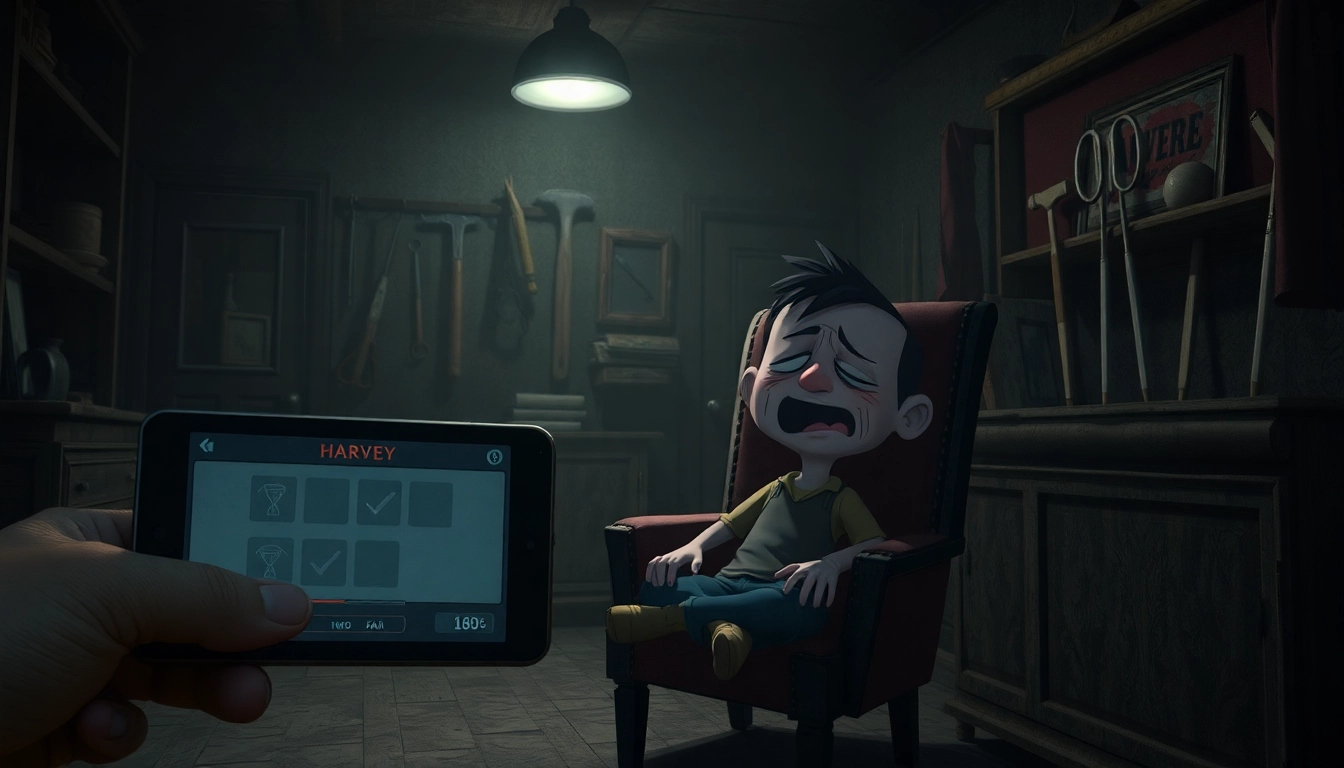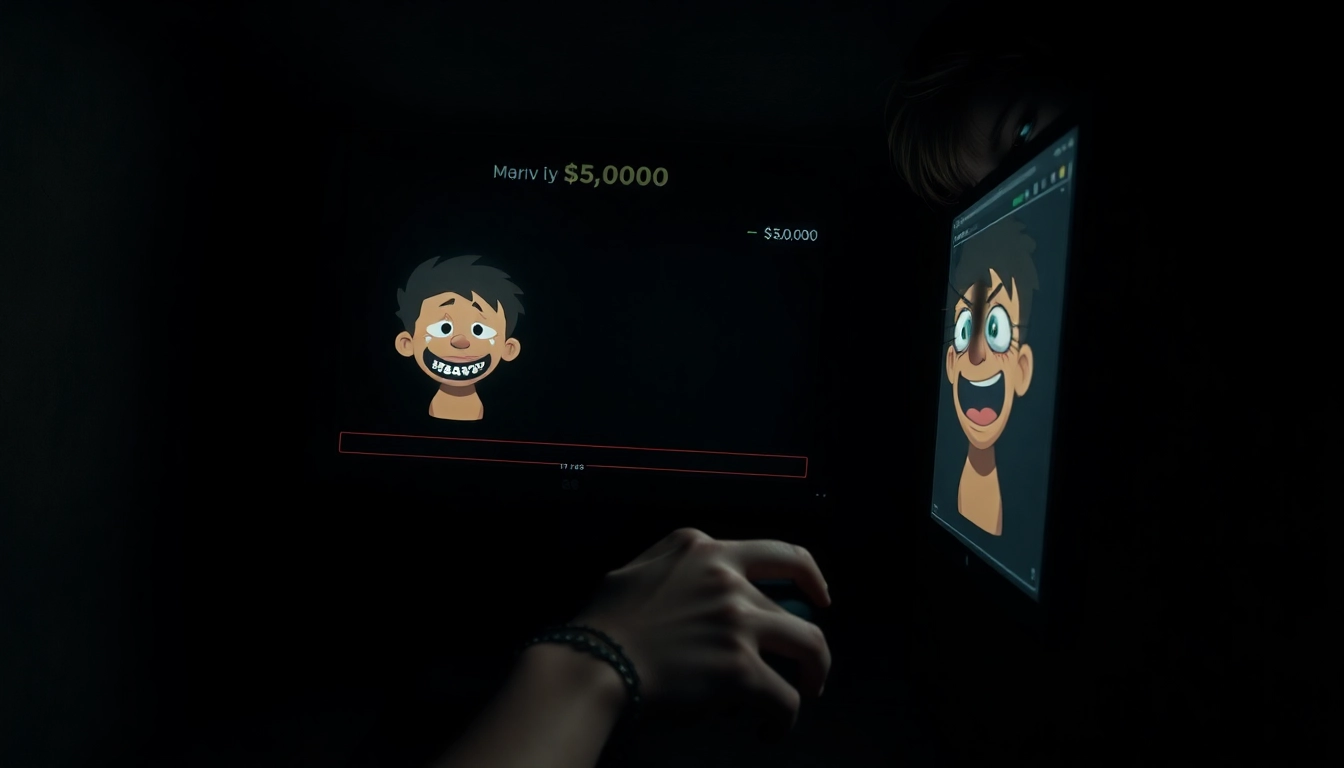Overview and Context: Bloodmoney – A Dark Psychological Clicker Experience
In the realm of psychological horror games, few titles manage to combine visceral storytelling with innovative gameplay mechanics quite like bloodmoney. This unsettling dark clicker game plunges players into a disturbing moral landscape where each click not only earns money but also chips away at the very essence of morality. Set against a backdrop of desperation and psychological torment, Bloodmoney explores the limits of human conscience through its grim gameplay and haunting narrative. As players navigate the treacherous path of survival, they are forced to confront uncomfortable questions about sacrifice, morality, and the true cost of life-saving decisions.
The Game Mechanics: Clicking, Upgrades, and Moral Choices
Core Clicking System
At its heart, Bloodmoney is a clicker game that challenges players to click on Harvey, a cheerful yet increasingly unsettling character, to generate funds. Initially, each click seems innocent—Harvey smiles and offers a dollar, creating a sense of straightforward reward. But as the game progresses, the visual and emotional toll intensifies, revealing the darker implications of each action.
Upgrade System and Tools
The shop system in Bloodmoney allows players to purchase upgrades that amplify earnings. These upgrades range from harmless-seeming tools like pillows, which evoke a sense of trivial violence, to more violent instruments such as scissors, needles, and hammers. Each purchase not only increases the money earned per click but also has psychological and visual repercussions—Harvey’s appearance deteriorates, and his reactions become more distressed. This creates a twisted risk-reward dynamic: the more brutal the tool, the faster the financial goal is reached, but at a greater moral and emotional cost.
Multiple Pathways and Endings
The game is designed with multiple pathways that lead to three distinct endings—The Good Ending, The Normal Ending, and The Bad Ending. These outcomes depend heavily on the player’s choices regarding how much harm they inflict on Harvey. Opting for minimal harm, even with the more violent tools, can lead to a more compassionate ending, while maximizing efficiency regardless of suffering results in the darkest conclusion. These choices are subtly tracked by the game, emphasizing that every decision leaves a lasting imprint on Harvey’s fate and the player’s moral standing.
The Dark Narrative of Bloodmoney and Harvey
Harvey’s Role and Character Development
Harvey serves as the innocent face of the game—an eager, cheerful figure who offers a seemingly simple opportunity to earn money. However, as the game unfolds, players notice subtle clues suggesting Harvey might be unaware of the true nature of the shop’s offerings. His surprise at discovering more violent tools indicates a level of innocence or ignorance, complicating the moral landscape. Is Harvey merely a puppet, or does he represent a fragile innocence caught in a corrupt system? This ambiguity heightens the psychological horror, compelling players to question their own morality and the nature of innocence in corrupt circumstances.
The Moral Dilemmas and Psychological Horror
Bloodmoney masterfully creates an atmosphere of dread and moral tension. Every click and upgrade decision pushes players closer to a moral abyss. The visual cues—Harvey’s deteriorating appearance, his increasingly distressed reactions—serve as visceral reminders of the human cost behind each profit. The game’s psychological horror extends beyond mere visuals; it probes the player’s conscience, forcing them to grapple with the uncomfortable reality of their choices.
Time Pressure and Urgency
Compounding the moral dilemma is the ticking clock—players need to raise $25,000 for urgent medical bills. The looming deadline injects a sense of desperation, pushing players to make increasingly questionable decisions under pressure. This time constraint mirrors real-life scenarios where urgent needs can cloud moral judgment, making Bloodmoney a mirror to human nature when survival is at stake.
Featured Gameplay Videos and Community Insights
Many gamers and content creators have explored Bloodmoney’s disturbing depths through gameplay videos, revealing subtle nuances and hidden mechanics. These videos often highlight how different choices impact the story’s progression and endings. For example, some players have managed to achieve the Good Ending even while using the most violent tools, challenging initial assumptions about the game’s morality. Community discussions often focus on Harvey’s reactions, the meaning of the shop’s offerings, and the psychological effects of the game’s emotional design.
Reddit threads and YouTube breakdowns have become treasure troves of insight, with players sharing their playthrough strategies and moral reflections. They often note how Harvey’s surprise at more violent tools suggests a deeper layer of innocence—a player’s moral compass being tested by their own decisions. This communal engagement enriches the experience, turning what is initially a solitary horror game into a shared exploration of morality and human nature.
Clicking Mechanics: The Heart of the Experience
At its core, the clicking mechanic is deceptively simple but profoundly impactful. Each click is a micro-decision—do I click quickly to maximize profit, or slow down to minimize Harvey’s suffering? The game subtly tracks the player’s behavior, influencing the visual and emotional tone of Harvey’s reactions. This mechanic creates a visceral connection between player action and moral consequence, making every decision feel weighty and personal.
Upgrade System: Enhancing Profit at a Moral Cost
The upgrade system is designed to evoke a sense of escalating violence. Initially, upgrades are benign—pillow fights and harmless tools. But as players buy more violent upgrades, Harvey’s suffering intensifies visibly and audibly. The game visually depicts Harvey’s pain through progressively distressed expressions, trembling, and altered animations. These cues serve as a stark reminder of the human cost of relentless pursuit of profit, forcing players to confront their own complicity in the cycle of violence.
Interestingly, some players have discovered that certain endings can be achieved without the most violent upgrades, indicating that the game’s tracking of moral choices is nuanced. The subtlety of these mechanics enhances replayability and moral reflection, encouraging players to experiment with different paths to see how their choices influence the ending and Harvey’s fate.
Multiple Pathways and Endings: The Moral Spectrum
The Good Ending
The Good Ending is achieved when players prioritize minimal harm, choosing the less violent tools and avoiding unnecessary suffering—even when pressed for time. In this route, Harvey’s appearance remains relatively intact, and his reactions are less distressed. The narrative concludes with Harvey still somewhat hopeful or resigned, emphasizing themes of mercy and moral integrity amidst desperation.
The Normal Ending
The Normal Ending strikes a balance, where players use moderate violence—perhaps opting for scissors or needles—to reach their financial goal. Harvey’s suffering is noticeable but not extreme, and the ending reflects a compromise between morality and necessity. This pathway suggests that in desperate situations, moral boundaries can be blurred but not entirely erased.
The Bad Ending
The Bad Ending is the darkest outcome—players maximize profit regardless of Harvey’s pain, often purchasing the most violent upgrades like hammers. Harvey’s visual state is grim, and his reactions are filled with terror and despair. The story concludes with Harvey broken, symbolizing the moral collapse of the player’s choices. This ending starkly questions the human cost of unchecked greed and survival at any expense.
The Hidden Depths and Psychological Layers
Beyond its surface mechanics, Bloodmoney subtly examines the duality of human nature. Harvey, representing innocence and hope, is contrasted sharply with the shop’s violent upgrades, controlled by darker forces. The game’s narrative hints that Harvey might be unaware of the true nature of the tools, adding a layer of tragic innocence to the moral calculus.
Repeated playthroughs reveal that even choosing the most violent options can sometimes lead to the Good Ending, suggesting that the game tracks more than just raw choices—it probes the player’s moral reasoning and emotional responses. This layered design creates a complex psychological experience, where the player’s empathy and conscience are constantly tested.
The Final Choice and Its Consequences
As players near their financial goal, the game reaches a crescendo—an ultimate moral crossroads. Do they continue maximizing profit at Harvey’s expense, or do they try to minimize his suffering? The final decision determines which ending they receive, with each choice carrying profound moral implications. The game’s conclusion leaves players pondering whether survival justifies moral compromise or if mercy should prevail even in desperation.
About Bloodmoney and Its Related Games
Bloodmoney has garnered a niche yet dedicated following, inspiring discussions and comparisons with other dark clicker and psychological horror titles. Its unique blend of moral dilemmas and visceral gameplay has made it a standout in the indie horror scene. Fans often explore related games that delve into similar themes of morality, survival, and psychological torment, broadening the conversation about the role of morality in gaming.
Connect With Us and Engage with the Community
If you’ve experienced the haunting depths of Bloodmoney, join the community to share your insights, strategies, and moral reflections. Watching gameplay videos and reading community analyses can deepen your understanding of the game’s layered narrative. Whether you favor the path of mercy or ruthless efficiency, your choices contribute to an ongoing dialogue about morality and human nature in gaming. Stay tuned for future unsettling experiences and insights from creators like SHROOMYCHRIST, who continue to push the boundaries of psychological horror in interactive media.
Conclusion: Morality, Survival, and the Power of Choice in Gaming
Bloodmoney stands as a testament to how video games can challenge our deepest moral beliefs while delivering compelling gameplay. It masterfully combines dark humor, visceral visuals, and nuanced storytelling to create an experience that is both disturbing and thought-provoking. Every click becomes a moral act, testing how far we’re willing to go when faced with life-and-death stakes. The game’s multiple endings serve as a mirror to our own values—do we choose mercy or maximize profit at any cost? As you reflect on your journey through Bloodmoney, remember that the game’s true power lies in its ability to make us question the very nature of morality and human resilience.
Ultimately, Bloodmoney’s message resonates beyond the screen: in moments of desperation, our choices reveal who we truly are. Will you stand for compassion or succumb to greed? The answer depends on your moral compass—and the decisions you make in this dark, psychological journey. For those willing to explore the depths of their conscience, Bloodmoney offers a haunting, unforgettable experience. Discover your own limits and see how far you’re willing to go when your life depends on it. Dive into the game’s unsettling world and ask yourself—how much are you willing to sacrifice for survival?
For more information and to experience this disturbing journey firsthand, visit bloodmoney. Remember, your choices matter—every click counts.


